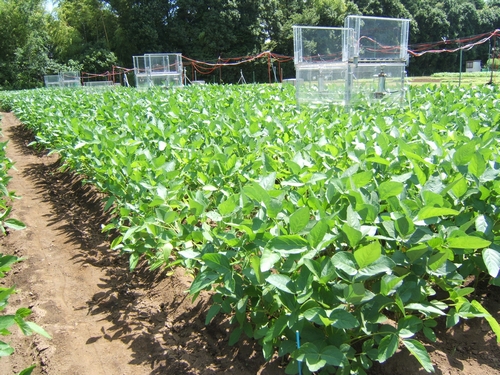February 23, 2013
NIAES, Tohoku University Jointly Develop World's First N2O Emission-Cutting Technology Using Microorganisms
Keywords: Climate Change University / Research institute

Copyright National Institute for Agro-Environmental Sciences
The National Institute for Agro-Environmental Sciences (NIAES) and Tohoku University, both in Japan, announced on November 12, 2012, that a research group has succeeded in producing Bradyrhizobium japonicum with increased nitrous oxide reductase (N2OR) activity and in demonstrating, both in the laboratory and in an outdoor field, that it can mitigate soil emissions of nitrous oxide (N2O), which is one of the causal substances of global warming and ozone depletion. This technology is the first in the world to cut N2O emissions using microorganisms.
N2O, which has 300 times more greenhouse potency than carbon dioxide, is mainly generated by farmland. It is expected that technology to reduce the emissions of N2O from farmland will soon be developed, as farmland contributes to 26 percent of the human-induced sources of N2O in Japan, while the figure is 60 percent worldwide.
The root nodule bacteria that live symbiotically with soybean possess an enzyme that reduces N2O to nitrogen gas. The research group of Tohoku University discovered that these rhizobium strains remove N2O, while NIAES established a precision measurement technology for N2O. When the groups collaborated, they succeeded in producing bacteria with enhanced N2OR activity (7 to 11 times higher).
The Tohoku University-NIAES joint research group then established methods to culture and inoculate the enhanced rhizobia into target plants. They evaluated their methods in a pilot-scale test, and then a field experiment was performed; the post-harvest N2O emissions due to degradation of soybean root nodules were reduced by 47%. The research results can be found in "Nature Climate Change," a British scientific magazine, published online on November 11, 2012.
Related
"JFS Newsletter"
- Shaping Japan's Energy toward 2050 Participating in the Round Table for Studying Energy Situations
- Implementation of the Paris Climate Agreement: A Report on Japan's Round Table for Studying Energy Situations
- Auto Sales Industry Cooperates to Tackle Social Responsibility: Examples from Yamagata, Japan
- Yokohama FC: Leader in Eco-Activities through Football-Related Carbon Offset
Related
"Popular Articles"
- Large Ozone Hole Observed Again in 2011
- Japan's Pro Baseball Teams Start Eco-Project to Cut Energy Use by 6%
- Manufacturer Saving Energy by Growing Vertical Gardens on Factory Walls
- Sony Draws Up 'Road to Zero' Plan for Zero Environmental Footprint
- Tokyo Announces Innovative 10-Year Strategy against Climate Change


